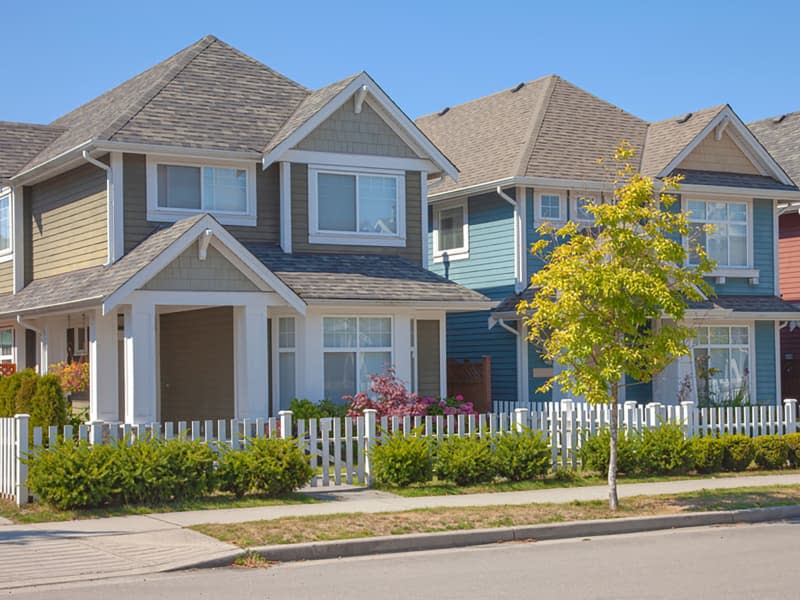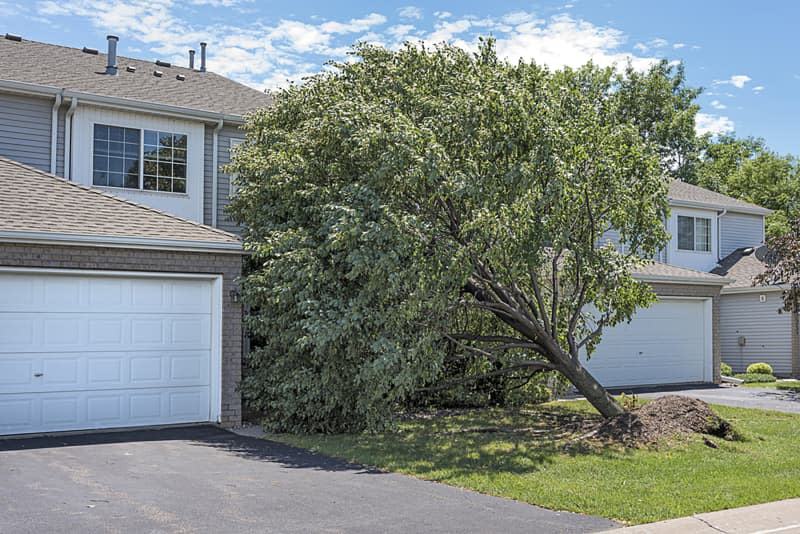5 Expensive Yard Problems Your Neighbors Could Blame You For

Turn your outdoor space into a summer oasis with decorating hacks, no-fail lawn and garden tips, and more with Yard Therapy. This content is presented by The Home Depot; it was created independently by our editorial team.
In a perfect world — or neighborhood, at least — no one mows their lawn too early in the morning, people pick up after their pets, and your neighbor will hold a package for you if it was delivered while you were away. These are all simple gestures that help keep the peace. But neighborly relations are tested when more significant (and expensive!) issues pop up, like when a dying tree that straddles property lines needs to be removed or a dilapidated fence between two homes is due to be replaced. These scenarios beg the question: Who should pay to fix the problem?
We asked experts to weigh in on five pesky yet common yard-related issues, from tree removal to mosquito woes. Ahead, we help you determine who should take ownership of the maintenance — whether that’s you, your neighbor, or a joint effort.
Scenario 1: A Dead Tree Needs to Be Removed — And It Straddles Properties
Dead trees are unsightly and can ding your property value, says Sal Bracale, chief operating officer at Moon Valley Nurseries, which has locations along the West Coast and in the South. He says dead trees also pose safety hazards because they could topple onto a car, fence, or home. Plus, rotted trees invite pests and diseases into the surrounding landscape.
The most obvious sign it’s time for removal is if a tree is leaning severely or falling over. Limbs breaking off during wind storms, pests taking up residence in the tree, and no green leaves or new growth sprouting are other telltale signs it’s likely time for tree removal, Bracale says.
Bracale says that most often, if a stump is entirely on your property, you pay for the removal — the average cost to remove a tree is about $1,200, according to Forbes.
But if the tree’s root is spread between two properties or the tree straddles properties, you’re probably curious: Who is responsible?
Generally speaking, in property law, a landowner owns everything within their property line boundaries, including what’s right under the surface, says Nichole Shelton, J.D., managing attorney of Nichole T Compton & Associates PLLC in Louisville, Kentucky, who handles real estate disputes and is a mediator for a Realtors’ association. Shelton says that in most jurisdictions, any tree roots or branches within your yard are your responsibility — if the trunk or roots are in your yard, it’s your tree.
On the rare occasion a tree’s roots straddle the property line, you and your neighbor will have to discuss a path forward. “To avoid an angry neighbor or invite litigation, do your best to communicate with your neighbor to devise a plan for the tree removal,” she advises. Maybe you split the cost if there’s any gray area as to whose property the tree is on, or if your neighbor considers it their tree, they may offer to pay for the removal.
Shelton says if you can’t agree on splitting the cost with your neighbor, you may need to hire a land surveyor to confirm the property line. She also suggests checking with your homeowners’ association if you have one. Sometimes, an outside party like your HOA may be tasked with paying for the removal.

Scenario 2: A Storm Takes Down Your Neighbor’s Tree, but It Damages Your House
Shelton says the storm damage laws and codes will vary depending on where you live, but typically, if your neighbor’s tree falls in a storm and damages your house, your neighbor is responsible for the damage.
“You can kindly ask the neighbor for their insurance info, or ask them to make a claim,” she says.
You may instead make a claim on your insurance. In that case, your insurance carrier will likely fix the damage to your property but will also contact your neighbor’s insurance company through a process known as subrogation to recoup the payout, Shelton explains.
Scenario 3: Property Line Fence Boards Are Ready for a Replacement
If you have a chain link fence that’s starting to rust or a wood fence that’s rotting or is brittle, it’s time to replace it, says Justin Noss, president of All American Fence Erectors, a full-service fence company in Southern California.
A privacy fence costs about $3,300 for the average yard, depending on the materials and where you live, per Forbes.
Noss says the fence owner is usually responsible for its maintenance and upkeep, but often, a fence is shared between neighbors. “If it’s an equally shared and owned fence, the neighborly thing to do is for each owner to split the cost, but this can get murky,” he says.
While fences often benefit both parties, Noss says the person pushing for a new fence usually foots the bill. Have a conversation with your neighbor about splitting the cost of a fence replacement as soon as you notice your shared divider is reaching the end of its lifespan — that way, you’re not springing the expense on them. If a storm caused damage, you and your neighbor might be able to work with your respective insurance companies to cover any damage.
Shelton says an HOA may require a replacement for shared fences. She adds that some HOAs reserve the right to repair the fence and charge the homeowners for the maintenance. In extreme cases, if you don’t repay them, they could place a lien on your property. But depending on your HOA, the association may also pay for the repair with reserves that all tenants pay into with their monthly fee, in which case you wouldn’t have to pay out of your own pocket.
Similarly, if you have a hedge separating your properties, but it’s rotted or stopped growing on both sides, the diplomatic approach would be for both neighbors to split the cost. If there’s a disagreement on who the hedge belongs to, this is another instance, Shelton says, where you could call in a land surveyor.
Scenario 4: Standing Water Near Property Lines Is Causing a Mosquito Infestation
Summer means more time spent outside enjoying your backyard and hosting barbecues or al fresco dinners. One downside: bugs, especially pesky mosquitoes.
If your and your neighbors’ outdoor living spaces are swarming with mosquitoes, your best bet is to go in on a solution together for mosquito management. If standing water is on your neighbor’s lawn, you may want to bring up the problem diplomatically. Not only can mosquitoes cause itchy welts, but their bites can also transmit more serious diseases like West Nile Virus, points out Jim Fredericks, chief entomologist and the vice president of public affairs at National Pest Management Association.
Mosquitoes thrive in places like abandoned swimming pools and clogged gutters.
“Even small quantities of water, if left standing for more than a week, can allow mosquitoes to develop from egg to adult in the heat of the summer,” Fredericks says. Once they develop into flying adult mosquitoes, they can easily fly across property lines to bite neighbors.
He says pest control professionals can develop an integrated mosquito management program for homeowners. This program includes identifying mosquito breeding areas, eliminating standing water sources on a property, and treating the standing water and any mosquito resting locations.
If you’ve asked your neighbor to address the standing water, and they refuse, you could consider contacting your county’s inspections and permits department or code enforcement. Shelton says these departments are tasked with checking for violations like unregistered vehicles, houses in disarray, and unkempt yards.
“So, for instance, if the water is caused by tire marks in the dirt collecting rainwater or rusty old buckets sitting around, these items may violate the city or county code,” Shelton says. If your neighbor is in violation of a city or county code, they may get a warning or ticket.
Scenario 5: Seeds from Your Neighbor’s Weeds Are Blowing into Your Yard
Unfortunately, even if you believe you know where the seeds are coming from and they take root in your lawn, this situation is a bit tricky to prove, Shelton says. “The occurrence of them is natural and no one can control the seed’s trajectory,” she says.
Her advice is to consider talking with your neighbor and present the dilemma with a non-accusatory approach, offering to split the cost of having their yard treated for weeds. It’s also a good idea to treat your own yard with soil additives that can help prevent the weeds from growing.
If you’ve exhausted these efforts, you can escalate the issue by contacting a property law or real estate attorney, your local zoning or inspections office, or your HOA if you have one. However, litigating matters like this can cause lasting tension with your neighbors, so Shelton recommends considering it a last resort.

